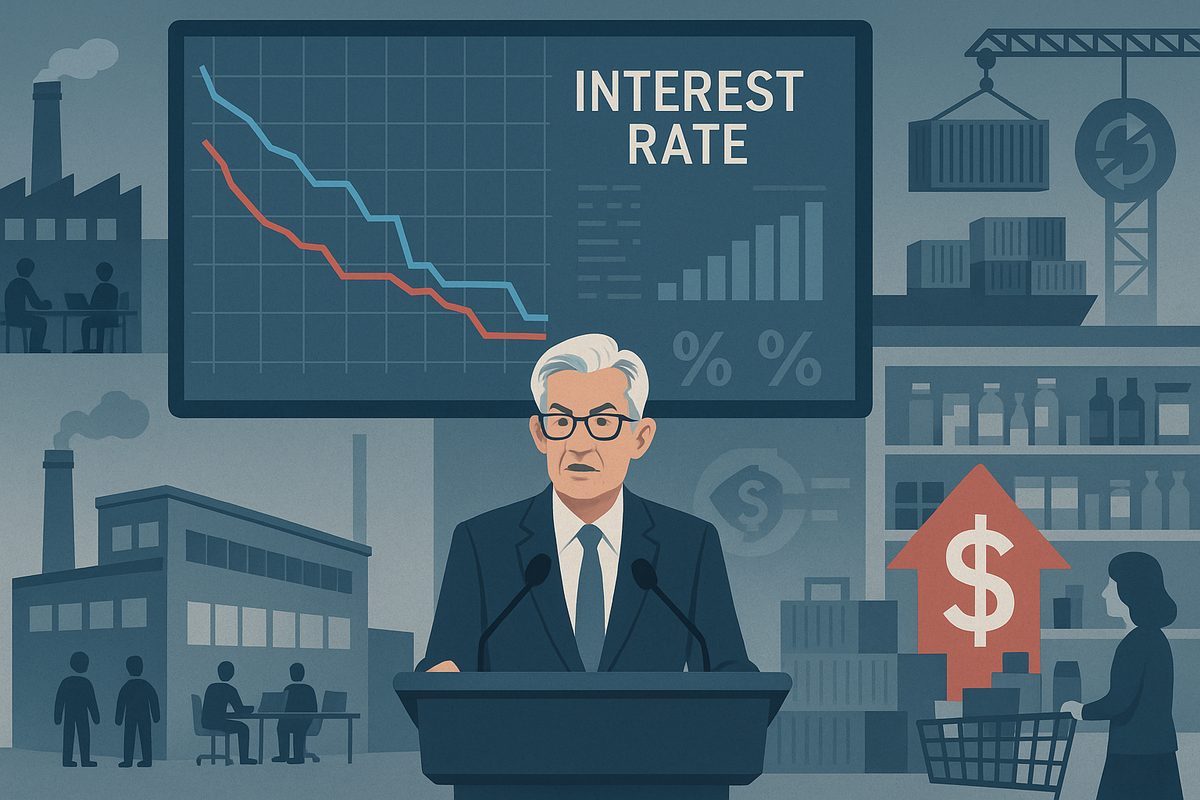
Federal Reserve Chair Jerome Powell's highly anticipated address at the Jackson Hole Economic Policy Symposium has sent ripples through financial markets, hinting at a potential pivot towards interest rate cuts in the near future. His remarks, delivered against a backdrop of evolving economic indicators, suggest a growing emphasis on the cooling labor market as a key factor influencing monetary policy decisions, even as persistent inflation risks, exacerbated by ongoing tariff pressures, remain a concern. This nuanced stance has immediate implications for investors, businesses, and consumers alike, signaling a possible easing of the tight monetary conditions that have characterized the past year.
The central bank's cautious optimism regarding the trajectory of the U.S. economy, coupled with a clear acknowledgment of the challenges ahead, underscores a delicate balancing act. Powell's speech is being interpreted as a strategic move to prepare markets for a more accommodative monetary policy, potentially offering a much-needed boost to economic activity while carefully navigating the complexities of price stability.
Powell's Jackson Hole Address: A Shift in the Fed's Stance
Jerome Powell's speech at the Jackson Hole Economic Policy Symposium was a pivotal moment, offering the clearest indication yet of the Federal Reserve's evolving perspective on the economy and its future monetary policy. The core of his message revolved around the observation that the labor market, a key focus for the Fed, is showing signs of cooling. This softening, he suggested, could provide the necessary room for the central bank to consider rate cuts, a significant departure from the aggressive tightening cycle of recent years.
The timeline leading up to this moment has been characterized by a relentless battle against inflation. For months, the Fed has maintained a hawkish stance, implementing a series of interest rate hikes to curb rising prices. However, recent economic data, including a gradual deceleration in job growth and a slight uptick in unemployment, appears to have shifted the Fed's calculus. Powell's comments at Jackson Hole represent a culmination of these evolving data points, signaling a potential end to the tightening cycle and the beginning of a new phase. Key players involved in this ongoing economic drama include the Federal Reserve's Open Market Committee (FOMC), which sets monetary policy, and various economic institutions and analysts who closely scrutinize every word from the Fed Chair.
Initial market reactions to Powell's speech were largely positive, with equity markets experiencing a modest rally as investors priced in the increased likelihood of rate cuts. Bond yields, particularly on shorter-term government bonds, saw a slight decline, reflecting expectations of lower future interest rates. The U.S. dollar also weakened against a basket of major currencies, as the prospect of a less aggressive Fed made dollar-denominated assets less attractive. This immediate response underscores the profound influence of the Federal Reserve's communications on global financial markets.
Navigating the Economic Currents: Potential Winners and Losers
The prospect of Federal Reserve rate cuts, as hinted by Chair Powell, creates a distinct landscape of potential winners and losers across various sectors of the economy. Companies that are highly sensitive to interest rates, particularly those with significant debt burdens or those reliant on consumer borrowing, stand to benefit considerably.
One clear winner could be the housing sector. Lower interest rates typically translate to more affordable mortgages, which can stimulate demand for homes and boost the fortunes of homebuilders like D.R. Horton (NYSE: DHI) and Lennar Corporation (NYSE: LEN). Similarly, real estate investment trusts (REITs) such as Simon Property Group (NYSE: SPG) could see increased investor interest as their cost of capital decreases and property values potentially appreciate. Technology companies, often characterized by high growth and a reliance on future earnings, also tend to perform well in a lower interest rate environment. Companies like Microsoft (NASDAQ: MSFT) and Apple (NASDAQ: AAPL), with their strong balance sheets and ability to invest in innovation, could see their valuations further supported. Furthermore, consumer discretionary companies, including retailers and automotive manufacturers, might experience a boost as lower borrowing costs encourage consumer spending. Companies like Amazon (NASDAQ: AMZN) and General Motors (NYSE: GM) could see increased sales volumes.
Conversely, certain sectors and companies may face headwinds. Banks and other financial institutions, while benefiting from a healthier economy, could see their net interest margins squeezed if the spread between what they pay on deposits and what they earn on loans narrows significantly. Large banks like JPMorgan Chase (NYSE: JPM) and Bank of America (NYSE: BAC) might experience some pressure on their profitability. Companies with substantial cash reserves that have been earning higher returns on those reserves in a high-interest-rate environment might also see a slight dip in their investment income. Additionally, sectors that thrive on higher interest rates, such as certain fixed-income investments, might become less attractive to investors seeking higher yields.
Industry Impact and Broader Implications
Jerome Powell's subtle shift in tone at Jackson Hole carries significant implications that extend far beyond immediate market reactions, potentially reshaping broader industry trends and policy considerations. This potential pivot towards rate cuts signals a recognition by the Fed that the economy may be entering a new phase, one where the risks of overtightening could outweigh the benefits of continued aggressive inflation fighting. This aligns with a broader trend among central banks globally, many of whom are grappling with similar challenges of balancing inflation control with economic growth.
The ripple effects of such a policy shift could be profound. Competitors and partners across various industries will need to re-evaluate their strategic plans. For instance, in the technology sector, a lower cost of capital could fuel increased investment in research and development, potentially accelerating innovation and intensifying competition. In the manufacturing sector, reduced borrowing costs could encourage expansion and modernization, leading to increased production and potentially lower consumer prices. Furthermore, the prospect of rate cuts could influence international trade dynamics, as a weaker dollar might make U.S. exports more competitive, benefiting multinational corporations.
From a regulatory and policy perspective, a more accommodative Fed could alleviate some of the pressure on fiscal policy. Governments might find it easier to finance public spending if borrowing costs are lower, potentially leading to increased infrastructure projects or social programs. Historically, periods of monetary easing have often been followed by economic expansion, though the specific outcomes are always contingent on a multitude of other factors. Comparisons to previous cycles of Fed easing, such as those following the 2008 financial crisis or the early 2000s dot-com bust, offer valuable insights but also highlight the unique challenges of the current economic environment, particularly the lingering effects of supply chain disruptions and geopolitical tensions.
What Comes Next: Navigating the Path Ahead
The path forward following Jerome Powell's Jackson Hole speech is fraught with both opportunities and challenges, requiring careful navigation from policymakers, businesses, and investors alike. In the short term, markets will be keenly watching for further signals from the Federal Reserve, particularly upcoming inflation data and labor market reports. Any significant deviation from the current trajectory could prompt the Fed to adjust its stance, either accelerating or delaying potential rate cuts. Businesses, in turn, may begin to strategically pivot, taking advantage of potentially lower borrowing costs to invest in expansion, research, or debt refinancing. This could lead to increased capital expenditure and, ultimately, job creation.
Looking further ahead, the long-term possibilities are more varied. A successful "soft landing," where inflation is brought under control without triggering a severe recession, remains the ideal scenario. In this outcome, sustained economic growth, coupled with moderate inflation, could create a favorable environment for corporate earnings and asset appreciation. However, challenges persist, including the ongoing geopolitical landscape, potential resurgences of inflation due to supply-side shocks, or an unexpected weakening of the labor market. Companies will need to adapt by building resilient supply chains, diversifying their revenue streams, and maintaining flexible operational models to weather potential economic volatility.
Market opportunities may emerge in sectors that are poised to benefit most from lower interest rates and a potentially stronger economy, such as technology, housing, and consumer discretionary. Conversely, challenges could arise for sectors that thrive in higher interest rate environments or those particularly vulnerable to economic downturns. Potential scenarios range from a gradual, controlled easing into a period of sustained growth to a more volatile path marked by intermittent economic headwinds. Investors should closely monitor the Fed's communications, key economic indicators, and corporate earnings reports to make informed decisions in the coming months.
Conclusion: A New Chapter for Monetary Policy
Jerome Powell's speech at the Jackson Hole Economic Policy Symposium marks a significant turning point in the Federal Reserve's approach to monetary policy, signaling a potential shift from aggressive tightening to a more accommodative stance. The key takeaway is the Fed's increased focus on the cooling labor market as a justification for considering rate cuts, even as inflation risks, particularly from tariffs, remain on the radar. This nuanced perspective suggests a delicate balancing act aimed at achieving a "soft landing" for the U.S. economy.
Moving forward, the market will be closely scrutinizing every piece of economic data and every statement from Fed officials. Investors should pay particular attention to inflation figures, employment reports, and consumer spending trends, as these will be crucial in determining the timing and magnitude of any future rate adjustments. The potential for rate cuts could usher in a period of renewed economic growth and investment, but it also carries risks, including the possibility of reigniting inflationary pressures or an unforeseen economic downturn.
The lasting impact of Powell's Jackson Hole address could be the beginning of a new chapter in monetary policy, one where the Fed prioritizes a more flexible and data-dependent approach. This shift underscores the dynamic nature of economic management and the continuous need for adaptation in the face of evolving global and domestic conditions. For investors, the coming months will demand vigilance and a strategic approach to portfolio management, as the economic landscape continues to unfold.






